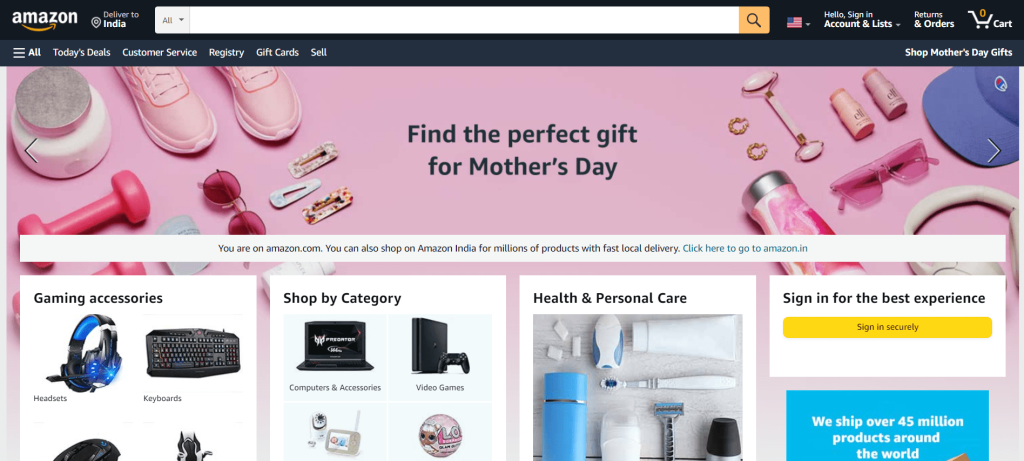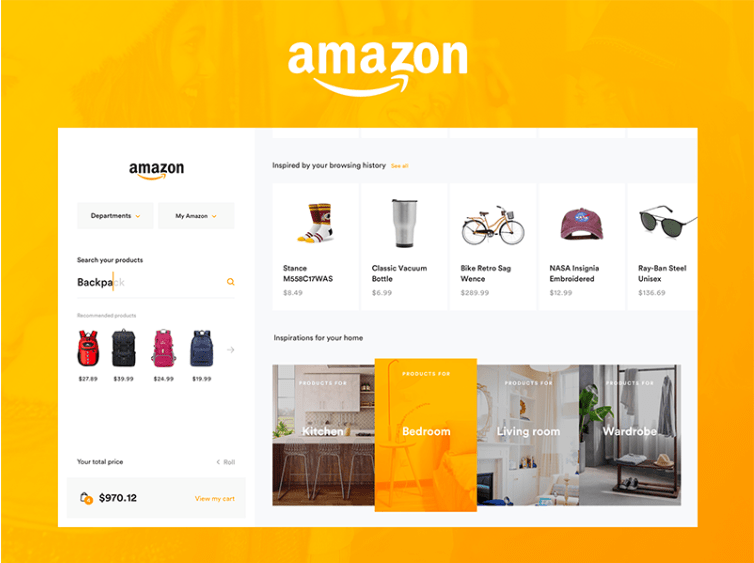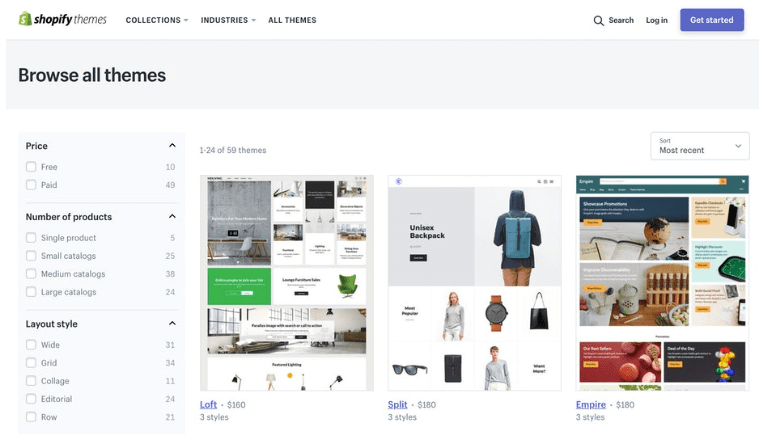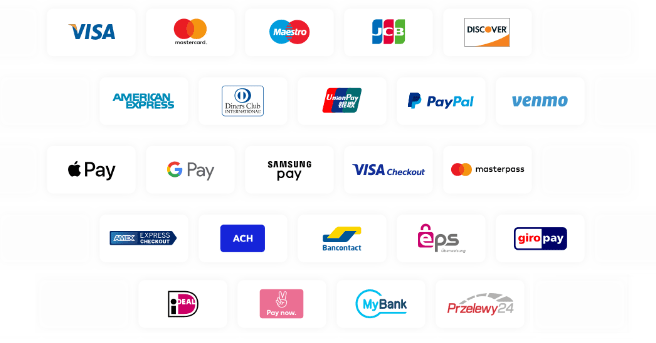Regarding eCommerce, Shopify and Amazon are two of the biggest names in the industry. Both offer many features, making them attractive options for entrepreneurs building an online store.
But while Shopify lets you create your store with its unique look and feel, Amazon offers access to millions of customers through its marketplace.
So which one is right for you? It all depends on your needs and goals. In this article, we’ll compare Shopify vs. Amazon and examine their product differences, fees, payment options, customer service, and more.
We’ll also discuss how you can use each platform to maximize your success when selling online. From referral fees to Amazon Prime, explore the pros and cons of selling on Amazon or using Shopify to find the best fit.
So, let’s take a deep dive to make an informed decision.
Contents
- 1 Overview of Amazon and Shopify
- 1.1 Shopify vs Amazon – Features Comparison
- 1.2 Shopify vs. Amazon: Design and Customization
- 1.3 Amazon VS Shopify: Which Has Better Sales Management?
- 1.4 Amazon VS Shopify: Payment Options
- 1.5 Amazon VS Shopify: Sellers’ Fees/Pricing Plan
- 1.6 Amazon VS Shopify: Pros & Cons
- 1.7 Final verdict: Shopify is an e-commerce platform, while Amazon is an online marketplace
- 1.8 Frequently Asked Questions:
Overview of Amazon and Shopify
Shopify and Amazon are the two most excellent eCommerce platforms that allow businesses to promote their products on these platforms and sell online to make a profit. When you explore both, you see the massive difference between these platforms.

Amazon supports retailers and wholesalers in selling their products. In addition, Amazon supports multiple brands because it is an online marketplace with B2b and B2C business modules, while Shopify is only an e-Commerce store. In contrast, Shopify features a simple website that supports one kind of brand.

At the same time, Amazon sells products that effectively compete with the products of other sellers. But Shopify allows business owners to create their websites where only their brands will be visible. To clarify it further, let’s look at the features.
Shopify vs Amazon – Features Comparison
No matter which platform you choose to sell your products and services, checking the features offered by these eCommerce platforms is crucial. So, let’s closely look at the features offered by Shopify and Amazon.
Amazon Features:
Amazon is the biggest online retailer’s platform offering impressive features to run your business successfully. All you have to do is create your account and start selling your services. The features are as follows.
- Automatic VAT invoicing
- Amazon Business to reach new customers
- Unique business deals and exciting offers
- Best business pricing and huge discount offers
- Improve order visibility
- Better product pictures and pay-by-invoice functionality
- Easy shipping and shipping calculation
- Back-end product page edits
- Security and hosting included
In contrast, Amazon also provides the facility of shipping products to customers, but Amazon may charge a shipping fee, and Amazon FBA fulfills all the sales orders.
Shopify Features:
Shopify offers better features in comparison to Amazon. This eCommerce platform also offers great premium templates that assist you in building an excellent online store. Moreover, you’ll get many customization options, add-on features, and seamless integrations.
Other features are as follows:
- Free and premium themes
- SSL certificate for better security
- Multiple payment processing options
- Drag & drop editor for the website
- Customer profiles and accounts
- Product reviews and testimonials
- Seo and order management
- Customer accounts and profiles management
- Dropshipping and fulfillment
- Automated tax calculation feature
- Cart recovery
Our Verdict:
Amazon offers comparatively fewer features as compared to Shopify. This is because Shopify allows you to create your website to list your products, whereas Amazon only allows you to create a seller’s account and sell your services.
Also, the features offered by Shopify are constantly evolving to improve functionality. So, here Shopify is the winner.
Shopify vs. Amazon: Design and Customization
Once again, you’ll see a massive difference between both platforms’ customization and design. We know that Amazon is an online marketplace with limited customization options. However, that did not happen in the case of Shopify.

Shopify does offer endless customization and design features so that you can create your website layout. This platform allows business owners to create fantasy stores to list their items as professional sellers.
Moreover, you get tons of customized themes that are available for paid and free as well. The most significant advantage of using Shopify is its user-friendly interface. Plus, you get a plethora of shortcuts that are available to you to change the function.
Shopify is the best place to make your website that helps you stand out from the crowd. However, although Shopify is a great place to start your website, Amazon is more flexible in creating your seller stores. On top of this, you will be able to sell an enormous number of products without any hassles.

The only downside is you don’t have such extended themes to change the layout and have limited customization options. Aside from this, Amazon doesn’t allow you to create your site but showcase your products on the homepage and sell them.
Amazon VS Shopify: Which Has Better Sales Management?
Amazon and Shopify are trying to make sales management as simple as possible. Regarding sales management, Amazon offers limitless sales management tools for retailers. Using the tool, you can sell many products; you don’t need to build a website.
Amazon is a great online marketplace that supports the e-Commerce business in multiple ways. Moreover, you can sell customized and handmade products and create targeted adverts here. You can also ship your items worldwide.
Amazon FBA is considered the most significant selling point of Amazon, allowing you to access the Prime account and generate maximum sales. On the same side, Shopify is also easy to use and offers impressive sales management features to run your online stores.
Moreover, you can track sales and set up real-time alerts to target the inventory. You can also integrate the Shopify account with social media platforms like eBay, Amazon, and Facebook. Shopify has everything that allows you to create your store and advertising tools.
You also get multiple payment processing features, digital selling options, and drop shipping facilities to manage sales. In this debate, Shopify and Amazon have tough competition, and it isn’t easy to decide which is the best.
Amazon VS Shopify: Payment Options
Payment options are an essential thing to consider when choosing the best online retail store for your business. It is always great to have multiple payment options so that customers can make payments quickly and buy the products.
People also prefer to have an e-commerce store that offers myriad payment options. Shopify here provides the best payment options if you are satisfied with the transaction fee. Above this, hundreds of payment choices are available, such as PayPal, Visa Card, Net banking, and many more.

Amazon is no less than Shopify because it offers you multiple payment options. However, Amazon is the prime payment method available to customers to make payments.
It also accepts all payment methods, such as credit cards, debit cards, and many more. In addition, there is a tie between Amazon and Shopify, so you can choose any of these platforms to create a seller’s store.
Amazon VS Shopify: Sellers’ Fees/Pricing Plan
Both these e-Commerce platforms charge fees to sellers. The fee will be applied as shipping payment and commission on the sales. However, the platform may cost you a higher seller fee if you access the fulfillment by the amazon program.

However, the fee may vary according to the type of product you sell on Amazon. For instance, if you sell the product at $29.99, you’ll pay $4.50 as a selling fee, which will be included in the overall cost.
On the same side, Shopify offers three main pricing plans. Basic, Shopify, and Advanced plan. The basic plan is $29/month, Shopify at $79/month, and advanced Shopify at $299/month.

The basic plan also has several features that are enough to start your e-Commerce business. But if you want to leverage the tools and features, you can choose the advanced seller fee option.
Amazon VS Shopify: Pros & Cons
In this section, we have given the Pros & Cons of both Amazon and Shopify. Let’s get inside it.
Amazon Pros:
- Easy to set and sell process.
- Great brand exposure.
- Access to selling tools like Amazon FBA.
- Offer easy payment options.
- Gift cards are available, and discount offers.
- Security back-end environment.
Amazon Cons:
- Limited customization features.
- Difficult to take a stand in the marketplace.
- Amazon’s products compete with other products.
Shopify Pros:
- User-friendly interface
- Integration tools to run a website
- Offline selling opportunities and Amazon support
- Physical support and sellers’ services
- Seo tools to grow your website
Shopify Cons:
- High transaction fees.
- The added cost for integration tools and templates.
- You need to create the whole website to run your platform.
Related Read:
Final verdict: Shopify is an e-commerce platform, while Amazon is an online marketplace
Creating a straight, head-to-head comparison between these giant e-commerce platforms is difficult. However, these platforms offer unique selling tools and focus on different sales aesthetics.
However, you can list your products by creating an Amazon seller account. But with Shopify, you must build the entire store to showcase your product.
At the same time, Shopify does offer you the best e-commerce tools to run your business more smoother; Amazon is equal in terms of features and tools. But at Amazon, you have many opportunities to list your products and showcase your products right on the homepage of Amazon.
So, both options are vice-versa and offer several benefits. It’s now up to you which choice is based on your needs.
Frequently Asked Questions:
Yes, shipping charges will be applied if you make a bulk order. Shipping charges will also be applied if you order from a different country.
Both platforms are excellent for listing products and selling to make a profit. But if you only want to make sales, then Amazon will be best because you only need to create a seller’s account here and start listing the products you want to sell. But on Shopify, you must create a website listing the products.
Amazon is an online marketplace that offers you limited customization features. But Shopify is far better than Amazon in terms of customization features, as it allows you to create a website with compelling customization features and templates.
Amazon is an online marketplace that offers you limited customization features. But Shopify is far better than Amazon in terms of customization features, as it allows you to create a website with compelling customization features and templates.
Yes, you can sell on Amazon and Shopify at the same time. This is a great way to maximize profits and reach customers in both markets. With Amazon, you have access to its vast customer base and one of the most trusted online stores in the world.
Shopify allows you to create a professional online store with many products and services. To drive traffic and sales, you can also benefit from Shopify’s marketing tools, such as SEO optimization.

I’m a professor, serial entrepreneur and e-commerce expert with a passion for creating successful online business models. After achieving huge success in the Amazon FBA business, I decided to make it my mission to help my fellow sellers do the same through enjoy-aiia.com .
